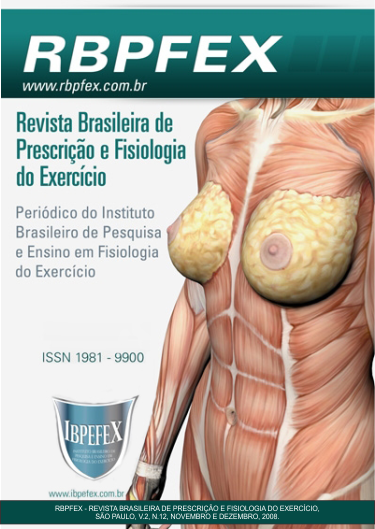Behavior of the physiological variable in women subjected to a training of 12 weeks of power jump program
Abstract
The Power Jump is an aerobic training executed in group, accompanied by music and pre-choreographed movements performed on an elastic surface. Being newly established little is known regarding the effects of training on the cardiovascular and neuromuscular variables. Thus, this study found the effects of this class of blood pressure, heart rate, cardio respiratory capacity (VO2max.), flexibility and vertical and horizontal impulse. The participants of the study were ten women that do not practice the way, aged between 18 and 23 years (average 19.6 ± 1.26) all in one group, being evaluated before and after the training, which was of twelve weeks, held three times a week and with one hour long. The results showed improvement in VO2max., decrease of the heart rate, increase in the level of flexibility and strength of lower limbs. It follows then that the twelve-week training program Power Jump, held on a regular basis contributes to improvement in cardiovascular and neuromuscular parameters, making them more strong and flexible, emphasizing that the greater the duration of training and increased the intensity of enforcement , the greater the benefits will be, can be an excellent option for improved cardio respiratory capacity.
References
- Allsen, Philip E.; Harrison, Joyce M.; Vance, Bárbara: Exercício e Qualidade de Vida: uma abordagem personalizada. 6ª.ed.São Paulo. Manole. 2001.
- American College Science Medicine: Programa de Condicionamento Físico do American College of Sport and Medicine. São Paulo. Manole. 1999.
- American College Science Medicine: Manual de Pesquisa das Diretrizes do ACSM para os Testes de Esforço e sua Prescrição. Rio de Janeiro. Guanabara Koogan.2003.
- Costa, R.F. Avaliação da Composição corporal: Teoria e Prática da Avaliação. São Paulo: Manole. 2001. 5- Costa, R.F. Manual Prático de Avaliação Física em Academias. São Paulo. American Medical do Brasil. 2005. 6- Foss, M.L.; Bowers, R.W.; Fox, E.L. Bases Fisiológicas da Educação Física e dos Desportos. 4ª ed. Rio de Janeiro. Guanabara Koogan. 1998.
- Furtado, E.; Simão, R.; Lemos A. Análise do Consumo de Oxigênio, Freqüência Cardíaca e Dispêndio Energético durante as aulas de Jump Fit. Revista Brasileira de Medicina do Esporte. São Paulo. Vol. 10. Núm. 5. 2004. p. 371 – 375.
- Grossi, T.; Guglielmo, L.G.A.; Carminatti, L.J.; Silva, J.F. Determinação da Intensidade da aula de Power Jump por meio da Freqüência Cardíaca. Revista Brasileira de Cineantropometria & Desempenho Humano. Vol. 10. Núm. 2. 2008. p. 129 – 136.
- Guedes, D.P.; Guedes, J.E.P. Exercício Físico na Promoção da Saúde. Londrina. Midiograf.1995.
- Instructor Manual. Power Jump: Les Mills Body Training Systems. 2005.
- Matsudo, V.K.R. Testes em Ciências do Esporte. São Paulo. Aratebi. 2003.
- Mcardle, W.D.; Katch, F.; Katch, V. Fisiologia do Exercício: Energia, Nutrição e Desempenho Humano. 4ª. ed. Rio de Janeiro. Guanabara Koogan.1998.
- Novaes, J. S.; Vianna, J. M. Personal Training e Condicionamento Físico. 2ª. ed. Rio de Janeiro. Shape.2003.
- Powers, S.K.; Howley, E.T. Fisiologia do Exercício: Teoria e Aplicação ao Condicionamento e ao Desempenho, 3ª. Ed. São Paulo. Manole. 2000.
- Simões, A.C. (Org). Mulher & Esporte: Mitos e Verdades. São Paulo. Manole. 2003.
- Wilmore, J.H.; Costill, D.L. Fisiologia do Esporte e do Exercício: Controle Cardiovascular durante o Exercício. 2ª ed.São Paulo. Manole. 2003.
Authors who publish in this journal agree to the following terms:
- Authors retain the copyright and grant the journal the right of first publication, with work simultaneously licensed under the Creative Commons Attribution License BY-NC which allows the sharing of the work with acknowledgment of the authorship of the work and initial publication in this journal.
- Authors are authorized to enter into additional contracts separately for non-exclusive distribution of the version of the work published in this journal (eg, publishing in institutional repository or book chapter), with acknowledgment of authorship and initial publication in this journal.
- Authors are allowed and encouraged to post and distribute their work online (eg, in institutional repositories or on their personal page) at any point before or during the editorial process, as this can bring about productive change as well as increase impact and impact. citation of published work (See The Effect of Free Access).






